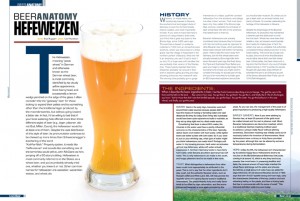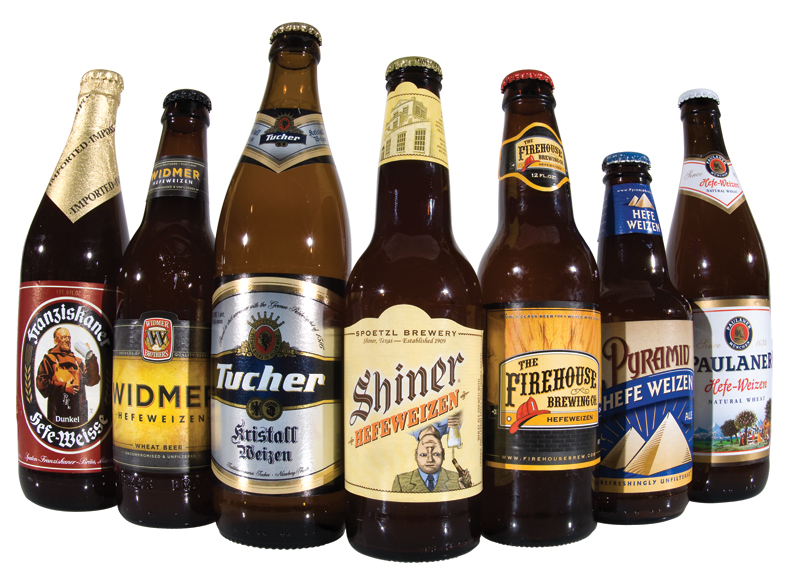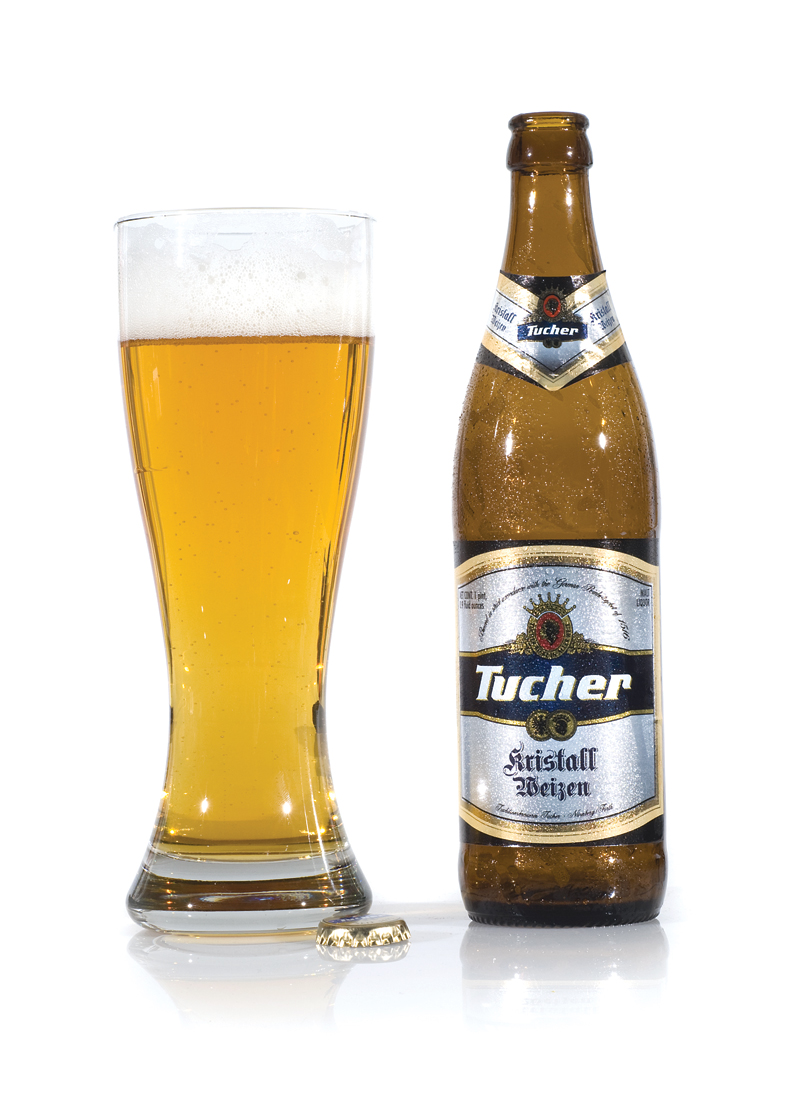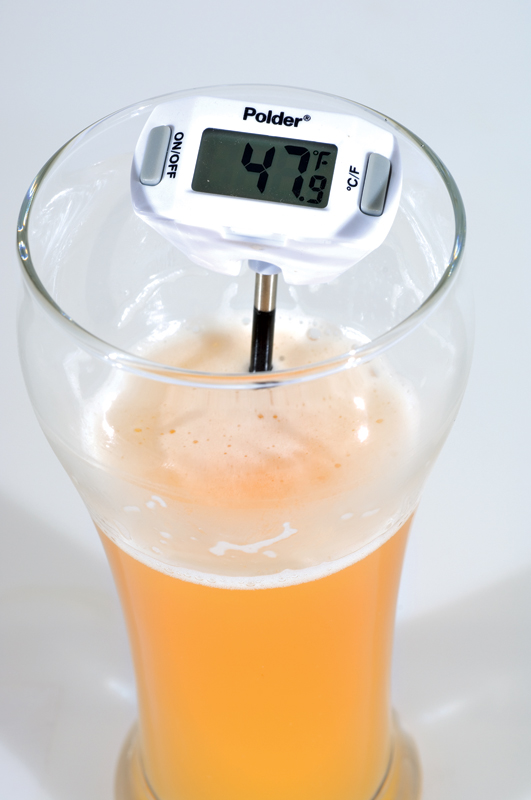Beer Anatomy
Hefeweizen
Words: Brad Ruppert
From the pages of Beer Magazine Issue #3

Check out all the stuff that you get in one issue!

The Hefeweizen, meaning “yeast wheat” in German and otherwise known as the German wheat beer, is most commonly identified by its cloudy yellow appearance, thick foamy head, and occasionally a lemon wedge perched on the edge of the glass. I often consider this the “gateway” beer for those looking to expand their palate and try something other than the traditional lager produced by the macrobreweries, but without going toward a bitter ale. In fact, I’d be willing to bet that if your local watering hole offered more than three different styles of beer (e.g., lager, pilsner, ale; not Bud, Miller, Coors), the hefeweizen would be at least one of them. Despite the vast distribution of this style of beer, its pronunciation continues to be chewed up more times than Schwarzenegger’s butchering of the word
“Kali-For-Niah.” Properly spoken, it reads like “heffe-vise-an” and sounds like something one of the terrorists would yell at John McClane as he’s jumping off a 60-story building. Hefeweizen is most commonly referred to in the States as a wheat beer, and you’ve probably already tried one, whether you knew it or not. Other common names for hefeweizen are weissbier, weizenbier, weisse, and wheat ale.

History
Weizens, or wheat beers, are traditionally brewed in Bavaria, the southernmost and largest state of Germany, known for its thick forests, historic castles, and most importantly its beer. If you were to trace Germany’s practice of using wheat to brew beer, you’ll find that it goes way back to the Bronze Age, some 2,800 years ago. This estimate is based on evidence collected in 1934 from an old earthenware amphora, which was discovered in a tribal grave near the village of Kasendorf in the northern portion of Bavaria. What the hell is an amphora, you say? (I had to look it up too.) It’s a huge vase with handles that was probably their version of the Stanley Cup. These heavily bearded Germanic tribesmen probably ran around in their wolf or bearskin garbs grunting and slap-shooting pinecones into makeshift nets. The winning tribe probably got to gorge themselves on a feast, quaff the coveted hefeweizen from the amphora, and pillage the other tribes’ women. That must have been why they called it the Bronze Age. Well, anyhow, scientists found traces of dark wheat beer still left on the amphora that dated back to that era.
Bavarian hefeweizens are actually considered ales because they’re brewed with top-fermenting yeast as opposed to other Bavarian beer styles, which are barley-based beers brewed with bottom-fermenting yeast. I hate to take the crown away from Germany, but the first wheat beers were actually brewed by Stone Age folks from seven thousand years ago that lived along the Tigris and Euphrates River. Before you pack your bags to make a pilgrimage to the founding home of beer, you might want to consider that today it’s actually part of Iraq, and you’d be more likely to stumble upon an IED (improvised explosive device) than you would a beer museum. So unless you’ve got a death wish, an armored vehicle, and plenty of Kevlar, I’d consider celebrating the heritage of the hefeweizen in Bavaria.
Despite the long lineage of the Bavarian hefeweizen, its production has maintained a tattered past that dates back to even the first batch. Wheat has never been that reliable a crop, so brewers would typically favor barley for making beer. In fact, the wheat crop was so unreliable that authorities considered limiting wheat production to only bread making. That would be a tough one to pass, since we all know that Bavarians would rather starve than lose their wheat beer. Unfortunately, bad beer made such a big stink that the Munich city council forbade wheat brewing in 1447 to protect its people. Roughly 69 years later, Duke Wilhelm IV extended this law to all of Bavaria as part of the famous Bavarian Beer Purity Law of 1516 (Reinheitsgebot).
The Ingredients:
When I describe the basic ingredients in beer, I feel like Frank Costanza describing a bra to George. “You got the cups in the front and the latch in the back … they come in four sizes. You got the A. You got the B. You got the C, and finally the D. The D’s the largest, you know.” But for those that didn’t see that Seinfeld episode, you got the hops. You got the water. You got the barley (or in this case wheat), and finally, you got the yeast.
Water: Back in the early days, breweries were built around fresh water sources because people didn’t have the means of routing or funneling water over vast distances like they do today. Even if they did, it probably would have been quite expensive to build or maintain, so they set up shop right next to a fresh water source.
Considering that beer is about 90% water, the minerals in the water used have a pretty influential outcome on the characteristics of the beer. Typically, darker beers work better with hard water, while lighter beers are better suited with soft water. So if you were to put on your drinking cap, what type of water might you think hefeweizens are made from? Perhaps soft water. In the brewing process, hard water accentuates upfront hop bitterness, while soft water actually suppresses it. Northern Germany tends to have fairly hard water, while Bavaria (southern Germany) has soft water. This is why hefeweizens are made in the south, and hoppy pilseners tend to be made in the north.
Yeast:
What distinguishes a hefeweizen from other beers could most appropriately be attributed to the yeast. This is not to say that the other ingredients don’t play a part, but the authentic Bavarian strain, such as Wyeast’s 3068 and White Lab’s 300, will help provide the requisite clove and banana flavors found in traditional hefeweizens. The predominantly fruity and malty flavor tends to be offset by high carbonation, and the aroma (cloves and bananas) is once again provided by the yeast. As you can see, the management of the yeast is of great importance to producing a high-quality hefeweizen.
Barley (Wheat): Now if you were abiding by German law, at least 50 percent of the grist must be malted wheat and the rest is pilsener malt. Most Bavarian hefeweizens are decoction mashed, which is a traditional German mashing method used to achieve a unique malty flavor without altering sweetness. Decoction mashing was initially used out of necessity before the invention of thermometers. Most hefeweizens have a citrusy or fruity flavor provided by the yeast, although this can be altered by extreme temperatures during fermentation.
Hops:
Unlike the IPA, the hefeweizen isn’t characterized by its extreme hoppy flavor. Hefeweizens tend to be very low on the IBU (International Bitterness Unit) scale, coming in at around 15, which is why they tend to be sweeter than most beers. In preserving tradition and taste, the minimal amount of hops helps maintain the wheat flavor and brings out the esters and phenols. Sometimes a small amount of noble hops are added for slight bitterness. An old electoral Bavarian decree of 1803 says that beer should “sparkle strong and foam high, carry the characteristic bitterness of the hop, cause a cool and refreshing feeling on the palate, and have a tickling taste that has to communicate with the sense of smell.” This historical definition holds true even today.
The Process
There are four stages to the brewing process, and different styles of beer are created by any number of tweaks within this process. In the initial step, the seeds of wheat or barley are boiled in a large pot as though you were making tea. This initiates the plant development process, causing enzymes to be released into the water, which are eventually used to break down proteins and starches in the grain. These enzymes turn the starches into sugars, which will later be consumed by the yeast. This initial boiling of the grains is referred to as the malting process.
In the second stage, the grains are crushed, soaked in water, and transformed into sugar. Along with this, proteins are broken down to create the body of the beer, and starches are broken down into simple sugars. As mentioned above, the yeasts will feast on these simple sugars, producing alcohol and carbon dioxide as bi-products. The sugars that aren’t consumed, aka complex sugars, will lend themselves to the malty taste. The heating of this mash is strained to produce what’s known as wort.
In the next stage, hops are added to the wort as it’s brought to a boil, which will release the aroma from hop oils and bitter resins. There are many factors that will contribute to the flavor of the beer, including the amount of hops added to the wort, the variety, and even the point at which they’re added. If it’s bitterness you seek, add plenty of hops early on. Adding hops during the middle of the boil contributes to the taste, and towards the end will enhance the aroma.
In the final step, the fermentation stage, the yeast is unleashed and goes to town on the sugars. But the temperature needs to be lowered to prevent killing the yeast. A certain amount of precaution is needed during this stage, as yeast is very sensitive to the external environment. Any number of contaminants in the air, or on a stirring device, can drastically alter the outcome of your beer. After this process, the beer is stored in a cool area for several weeks and allowed to ferment as well as carbonate. The carbonation is done by adding additional sugars, which the yeast will consume and use to give off carbon dioxide. Alternatively, it’s added artificially.
For extra carbonation, many hefeweizens are bottle-conditioned, which is the technique of adding unfermented beer to the fully fermented beer right before packaging the brew into bottles. The easiest means of explaining this process would be to think back to that time you took your date to that Mexican restaurant and you ordered that “gi-normous” carnitas burrito with the extra helping of refried beans. Consider the burrito to be the unfermented beer, while your stomach acids play the role of the yeast. The moment you stuffed that monstrosity down your gullet, your stomach went to work breaking down those proteins and starches into usable energy. Similarly for the beer, the yeast within the fully fermented beer stuffed the tablecloth under their collar and began to feast on the sugars within the unfermented beer. Roughly 30 minutes later, while driving your lady home, this pressure has built up as a result of an abundance of gas generated as a bi-product of your stomach and intestines having broken down that food. Unfortunately for you, the bomb you’re about ready to detonate (methane) could strip the paint off the walls, while the yeast consuming the sugars has produced harmless/odorless carbon dioxide. Thankfully, only one girl has to suffocate because of your burrito consumption, while the rest of us can enjoy a freshly carbonated beer with a wealth of pleasing aromas not related to the gas.

Variations
Bavarian-style weizen beers typically come in the filtered or unfiltered form, called “kristall weizen” or “hefeweizen,” respectively. Both are made from at least 50 percent wheat malt, with some recipes calling for upwards of 70 percent. They are best served at 45-50 degrees to fully appreciate their complexity and rich flavor. Throwing on that lemon wedge only destroys the head of the beer and offsets the beer’s natural flavor. This is a definite “rookie” move and should have been found in the article about “15 Things to Never Do in a Bar”.

There are also dark Bavarian wheat beers known as “dunkles weizen.” If it wasn’t obvious, “dunkle” means dark in German. (Didn’t know you were in for a linguistics lesson, did you, pal.) The dunkles are similar in aroma to their kristall or hefe, but tend to have a heavier roasted and malty flavor and scent. The dunkel, as with other dark beers, are better during the winter months or cold mornings. One word of caution. When I was in Germany, the barkeep mentioned that dunkles are a natural laxative, so take care not to consume too many. That advice came a day late and a dollar short, and I hesitate to tell you the story that went along with it.

The darker weisse beers also come in stronger versions, called the bock and doppelbock (double bock). Bock is a strong beer, said to have originated in the medieval brewing town of Einbeck, Germany. In fact, it’s thought that bock is a corruption of the town’s name, yet it also means goat (buck) in German. I recall having read a story about the origin of the bock being associated with these strong beers produced during the winter months. It was said that after the lads had thrown a few down the hatch, they were often seen running around and butting heads like billy goats. It most likely has something to do with the liquid courage flowing through their veins. The original bocks had a dark appearance and were brewed from high-colored malts. Modern bocks can range from dark, amber, or even pale in appearance. Because of its potency, bocks were traditionally brewed for special occasions, like Christmas, Easter, or Claudia Schaffer’s Birthday.
Additional History
“The known name weissbier (white beer) came about in order to make a distinction from the bottom-fermented braunbier (brown beer), a lager style that came into fashion in the middle of the 18th century because of improved brewing methods. For example, braunbier is considered “heavy” in the sense that much of its sediment and “ingredients” were bottom-brewed (sank to the bottom and retained there). On the other hand, in weissbier, the ingredients are more evenly distributed throughout the brewing process, resulting in a superior tasting, more highly desirable beer. It was highly appreciated by the drinking audience for being a light “summer beer.” Originally, the name weissbier was a collective term for all German pale ales and thus it referred to light barley ales as well as full-bodied wheats. Until the beginning of this century, shares of one-third wheat malt were usual. However, German brewing scientist Hess described a wheat brewing style in 1850 that used wheat malt exclusively.
The nobility and the cloisters had the exclusive rights for the brewing of wheat beer, producing a clear monopoly, and by ca. 1600 all of the weissbier breweries were either under the control of the nobility or the monks. Many in the political-religious community utilized monasteries as local taverns and restaurants, as well as congregating points. For example, in the 15th century, many dukes within Germany (especially Bavaria) created Benedictine Monasteries. These monasteries were created to serve not only for the adoration of God, but as “family” and regional monasteries for (social) congregation. Existing areas of monasteries were expanded to include study, dining, and sleeping areas. Ultimately, breweries were focused in these areas due to their central points of socialization and the simple fact that in Germany, beer was (and is) closely associated with public gatherings.”
www.american.edu/TED/weissbier.htm
Characteristics
• Appearance
Most folks’ initial response to a hefeweizen is one of awe. If poured correctly and housed in the weizen glass, it should tower over the traditional beers and appear like you just received an Oscar (golden statue) from your bartender for your ingenious fantasy football knowledge. The color can range from golden to pale straw, and usually has a very thick lingering white head and plenty of carbonation bubbles rising from the bottom. The cloudy appearance is attributed to the excessive proteins of the wheat, and the levels of cloudiness vary depending on the method of filtration, or whether it’s poured from a bottle or a keg.

• Smell
Hefeweizens have a predominant fruity smell resembling bananas, as well as a clove scent from the strong phenols. If you get your nose right down into the head of the beer, you can also smell the wheat that was used to make the beer. It’s a refreshing scent that is reminiscent of summertime in the country. Depending on how good your snout is, you might even be able to pick up a slight hop trace from the Noble hops used, but nothing like an IPA. Some have been said to detect hints of vanilla or even bubblegum, which is a characteristic of the esters in the beer.
• Taste
If your other senses haven’t failed you, then you’re probably ready to taste something sweet and fruity, in accordance with what you’ve inhaled. And rightfully so. Hefeweizens are usually quite sweet, citrusy, and taste much thicker than a lager or pilsener. Along with these unique tastes, you may detect a hint of bananas, vanilla, or even bubblegum. The proteins from the wheat also give the beer a bread-like flavor, as if you’re drinking your sandwich. The sweet taste of this beer is the perfect replacement for lemonade or orange juice on that early spring morning sitting on the porch. If you’re looking to convert the wife to beer, have her replace those Sunday mimosas with a nice hefeweizen and see what she thinks.
Serving Hefeweizen
Glass: The hefeweizen, similar to the pilsner, actually has a glass named specifically for it, called a weizen glass. It’s one of the tallest traditional beer glasses, other than the yard, standing at roughly 10 inches in height with a narrow base and a sleek mid-section that gives rise to a voluptuous bulb near the top. If you use your imagination a bit, the appearance resembles one of those buxom cartoon bombshells like Jessica Rabbit (tall, thin, and huge cans upstairs). The height is a definite factor, providing a stunning display of the beer and facilitating good carbonation. This also allows for a generous head, while the slight inward curvature of the rim helps focus the citrusy aroma. Although not as abundant as the traditional pint glass, which is stackable and easy to clean, the weizen glass can be found in most proper beer establishments. (Proper? I sound like a snobby Brit.) Let’s just say that if your bar serves you a hefeweizen in a weizen glass, then your bar is “proppa” (a la MC Hammer).
Temperature:
According to The Beer Hunter (Michael Jackson, world-renowned beer writer, recently deceased … moment of silence), hefeweizens should be served on the chilled side, somewhere around 47 degrees. Save your pink thermometers for the ladies and just know that this should be roughly as cold as that case of Pabst Blue Ribbon you’ve got in the fridge, but just a degree or two warmer. As a rule of thumb, lighter beers should be served at colder temperatures, while darker beers can have more abundant flavor at slightly higher temperatures. For the hefeweizen, the cold storage helps the yeast in the bottle remain stable, and once poured, the beer is slightly warmed by the glass, which allows the brilliant aromas of the beer to begin to emerge.

POURING
The Hefeweizen, like many beers, should be poured smoothly into a clean glass at a 45-degree angle. Be sure to use a weizen glass if you’ve got one to help bring out the best of this beer. If you’re pouring from a bottle instead of a keg, here’s where the hefeweizen tends to differ. Typically, you’ll find yeast sitting at the bottom of these beers, which is actually a desired and tasty addition. So continue your pour until you’ve got about a quarter of the beer left in the bottle, give it a decent swirl to stir the sediment, then finish pouring the rest into the glass. This will help provide a generous, fragrant head and release the yeast into the beer, which leads to the cloudy appearance. When purchasing a hefeweizen at any pub of Germanic origin, the bartender will always rouse the yeast sediment from the bottom of the bottle and make sure it ends up in your glass. This is considered a delicacy, and adds to the overall citrusy taste and floral aroma. While it may not be for everyone, consider this delicacy a gift and be thankful that you’re not in China, where monkey brains are the delicacy.

Food Pairing
Considering the citrusy fruit flavor, this beer goes well with just about everything on the summertime menu. BBQ’d bratwurst, tri-tip, ribs, chicken, and anything smoked on the grill are an excellent compliment to the hefeweizen. Even grilled or smoked fish pairs well. So if you’re out camping and you pulled in a few trout from the lake—whether by hook or dynamite—the hefeweizen is your beer. If you come home empty-handed from that salmon fishing excursion to Alaska, no worries; pick a few up from the local market on the way home, throw them on the grill, and crack open a hefeweisen.
German & Common Hefeweizens
German Hefeweizens:
Aldersbacher Kloster Weisse Hell
Ayinger Brau-Weisse
Darmstadter Privatbrauerei Wilhelm Rummel Weissbier Hefe Hell
Erdinger Weissbier
Hacker-Pschorr Hefeweizen
Hacklberg Hefe Weisse
Hof Hefe Weissbier (Sainsbury’s)
Kaiserdom Weizenland Weissbier Hefetrüb
Löwenbräu LöwenWeisse Hefe-Weissbier
Maisel’s Weisse
Oettinger Hefeweissbier Naturtrüb
Paulaner Hefe-Weizen
Paulaner Hefe-Weizen Dunkel
Riedenburger Weisse
Ritter St. Georgen Brauerei Weisser Franke
Roehrl Straubinger Blauweiss
Schmucker Hefe-Weizen
Schneider & Sohn Schneider Weisse Original
Schneider Aventinus
Schöfferhofer Hefeweizen
Spaten Franziskaner Hefe-Weissbier
Stumpf Keiler Weissbier Hell
Tucher Helles Hefe Weizen
Tucher Dunkles Hefe-Weizen:
Anon (Waitrose) Hefe-Weiss Bier
Waitrose Hefe-Weissbier
Weihenstephaner Hefe Weissbier

American Hefeweizens:
Abita Wheat—Abita Springs, LA
Alameda Wilshire Wheat Ale—Portland, OR
Altitude Tumblewheat—Laramie, WY
Anchor Summer Beer—San Francisco, CA
Anderson Valley High Rollers Wheat—Anderson Valley, CA
Bend High Desert Hefeweizen—Bend, OR
Bluegrass Summer Wheat—Louisville, KY
Boulevard Unfiltered Wheat Beer—Kansas City, MO
Breckenridge Hefe Proper Ale—Denver, CO
Bricktown Bison American Wheat—Oklahoma City, OK
CooperSmiths Mountain Avenue Wheat—Fort Collins, CO
Dragonmead Redwing Raspberry Wheat Beer—Warren, MI
Flagstaff Summer Wheat—Flagstaff, AZ
Founders Weizenbier—Grand Rapids, MI
Goose Island 312 Urban Wheat Ale—Chicago, IL
Grand Teton Workhorse Wheat—Victor, ID
Grants HefeWeizen—Yakima, WA
Great Divide Whitewater Wheat—Denver, CO
Hank is Wiser Wiseman Wheat—Cheney, KS
Harpoon UFO Hefeweizen—Boston, MA
J.T. Whitneys Honey Weiss—Madison, WI
Kona Hula Hefeweizen Kailua—Kona, HI
Lewis and Clark Miners Gold Hefeweizen—Helena, MT
M.J. Barleyhoppers Harvest Weizen—Lewiston, ID
Magic Hat Circus Boy South—Burlington, VT
McMenamins Edgefield Wheat—Portland, OR
Midnight Sun Fireweed Honey Wheat Beer—Anchorage, AL
Moylans White Christmas Double Wheat—Novato, CA
Odell Easy Street Wheat—Fort Collins, CA
Pizza Port Hot Spots Hefeweizen—Solana Beach, CA
Pyramid Hefeweizen—Seattle, WA
Rock Bottom Walleye Wheat—Cleveland, OH
Samuel Adams Hefeweizen—Boston, MA
Saranac Golden Pilsener—Utica, NY
Schlafly Hefeweizen—St. Louis, MO
Shiner Hefeweizen—Shiner, TX
Sierra Nevada Wheat Beer—Chico, CA
Six Rivers High Prarie Wheat—McKinleyville, CA
Smuttynose Summer Weizen—Portsmouth, NH
Stewarts Wacky Wheat Ale—Bear, DE
Three Floyds Gumballhead—Munster, IN
Tommyknocker Jack Whacker Wheat Ale—Idaho Springs, CO
Trail Creek Hefeweizen—Twin Falls, ID
Trinity Hefe Weizen—Providence, RI
Widmer Brothers Hefeweizen—Portland, OR
Yellowstone Valley Grizzly Wulff Wheat—Billings, MT
IBU ABV
Hefeweizen > 10-35 4-7%
berlinger weissbier > 3-6 2-5%
dunkelweizen > 10-25 4-7%
kristalweizen > 10-15 4-7%
weizenbock > 15-25 7-10%




Other great American Hefeweizens are Leinenkugel’s Sunset Wheat, Big Butt (dopplebock), Honey Weiss, and Berry Weiss.